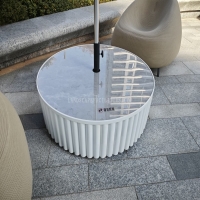Welcome to the website for landscape facilities products and knowledge.
What are the best materials for landscape tables in areas with high radon gas exposure?
When selecting materials for landscape tables in areas with high radon gas exposure, durability and resistance to radon penetration are critical. Radon, a naturally occurring radioactive gas, can degrade certain materials over time, compromising both safety and aesthetics. Here are the top materials to consider:
1. Stainless Steel: Highly resistant to corrosion and radon penetration, stainless steel is a durable choice for outdoor furniture. Its non-porous surface prevents radon absorption, making it ideal for high-radon environments.
2. Powder-Coated Aluminum: Lightweight yet sturdy, aluminum with a powder-coated finish offers excellent radon resistance. The coating adds an extra layer of protection against gas infiltration.
3. Composite Wood: Unlike natural wood, composite wood is engineered to resist moisture and radon. It mimics the look of wood while providing superior longevity in radon-prone areas.
4. Concrete with Sealant: Concrete is inherently dense, but applying a radon-resistant sealant enhances its durability. This combination ensures long-term performance in outdoor settings.
5. High-Density Polyethylene (HDPE): A plastic-based material, HDPE is impervious to radon and weather-resistant. It’s an eco-friendly option that requires minimal maintenance.
By choosing these materials, you can create landscape tables that withstand radon exposure while maintaining functionality and style. Always prioritize materials tested for radon resistance to ensure safety and longevity.
Related search:

Recommendation
Round metal tube border design table with tempered glass or granite countertop on the top.